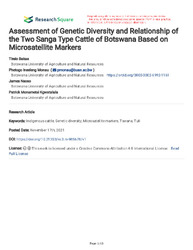| dc.contributor.author | Bakae, T. | |
| dc.contributor.author | Monau, P.I | |
| dc.contributor.author | Nsoso, S.J. | |
| dc.contributor.author | Kgwatalala, P.M. | |
| dc.date.accessioned | 2023-05-04T10:30:24Z | |
| dc.date.available | 2023-05-04T10:30:24Z | |
| dc.date.issued | 2022-06-10 | |
| dc.identifier.citation | Bakae, T., Monau, P. I., Nsoso, S. J., & Kgwatalala, P. M. (2022). Assessment of genetic diversity and relationship of the two Sanga type cattle of Botswana based on microsatellite markers. Tropical Animal Health and Production, 54(4), 210. | en_US |
| dc.identifier.issn | 00494747 | |
| dc.identifier.issn | 1573-7438 | |
| dc.identifier.uri | 10.1007/s11250-022-03212-9 | |
| dc.identifier.uri | http://link.springer.com/journal/11250 | |
| dc.identifier.uri | https://hdl.handle.net/13049/688 | |
| dc.description | Green Open Access | en_US |
| dc.description.abstract | The study was performed to evaluate genetic variation on two Sanga type cattle found in Botswana: Tswana and Tuli using twelve microsatellite markers. All amplified loci were polymorphic with 75 and 77 alleles genotyped in the Tswana and Tuli populations, respectively. The total number of alleles per locus ranged from 2 (BM1818) to 10 (TGLA227) with total mean of 6.25 for Tswana and 6.43 for Tuli population. Almost all the markers showed high polymorphic information content (PIC) apart from BM1818 (0.375) and INRA23 (0.393) which were moderately informative in Tswana population. Most of the markers were in Hardy–Weinberg equilibrium except for CSSRM60 and CSSM66 loci in Tswana population and ETH10, ETH225 and CSSM66 loci in Tuli population. A total of 103 unique alleles were genotyped across the two breeds with 49-shared, and 26 and 28 were unique to Tswana and Tuli populations, respectively. The expected heterozygosity (He) values were higher than the observed heterozygosity (Ho) in both populations: Tswana (He = 0.7895 ± 0.033 vs Ho = 0.631 ± 0.091) and Tuli (He = 0.8123 ± 0.033 vs Ho = 0.556 ± 0.021). The inbreeding coefficient was 0.200 ± 0.002 and 0.332 ± 0.001 in Tswana and Tuli populations, respectively. Analysis of molecular variance revealed 6.8% of the total genetic variation corresponding to differences between the two breeds and 93.2% within populations. The genetic identity between the two breeds was 56% and there were similar levels of multilocus heterozygosity and allelic diversity in the two breeds. The use of Tswana and Tuli breeds in a crossbreeding programme is likely to result in minimal heterosis and therefore not recommended. | en_US |
| dc.language.iso | en | en_US |
| dc.publisher | Springer | en_US |
| dc.relation.ispartofseries | Tropical Animal Health and Production.;54(4), 210 | |
| dc.subject | Genetic diversity | en_US |
| dc.subject | Indigenous cattle | en_US |
| dc.subject | Microsatellite markers | en_US |
| dc.subject | Tswana | en_US |
| dc.subject | Tuli | en_US |
| dc.title | Assessment of genetic diversity and relationship of the two Sanga type cattle of Botswana based on microsatellite markers. | en_US |
| dc.type | Article | en_US |

